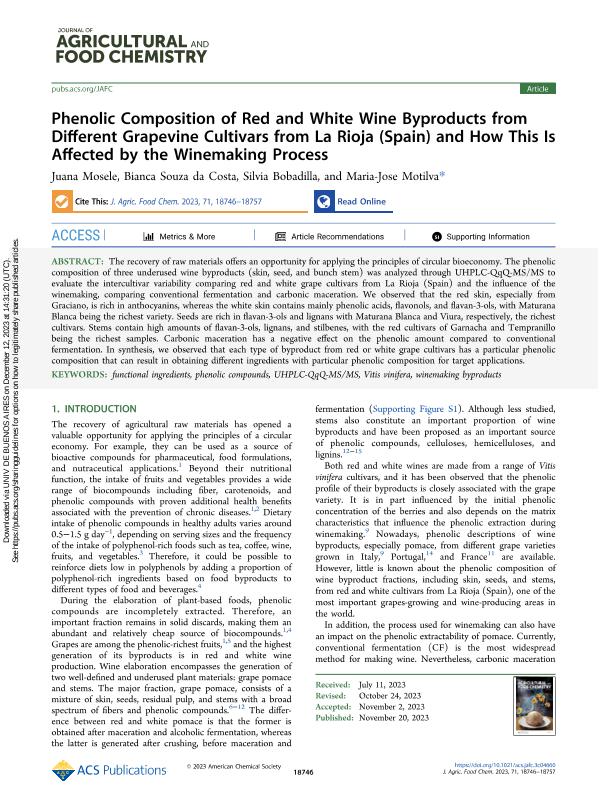Mostrar el registro sencillo del ítem
dc.contributor.author
Mosse, Juana Inés

dc.contributor.author
Souza da Costa, Bianca
dc.contributor.author
Bobadilla, Silvia
dc.contributor.author
Motilva, Maria Jose
dc.date.available
2024-02-21T13:16:55Z
dc.date.issued
2023-11
dc.identifier.citation
Mosse, Juana Inés; Souza da Costa, Bianca; Bobadilla, Silvia; Motilva, Maria Jose; Phenolic Composition of Red and White Wine Byproducts from Different Grapevine Cultivars from La Rioja (Spain) and How This Is Affected by the Winemaking Process; American Chemical Society; Journal of Agricultural and Food Chemistry; 71; 48; 11-2023; 18746-18757
dc.identifier.issn
0021-8561
dc.identifier.uri
http://hdl.handle.net/11336/227771
dc.description.abstract
The recovery of raw materials offers an opportunity for applying the principles of circular bioeconomy. The phenolic composition of three underused wine byproducts (skin, seed, and bunch stem) was analyzed through UHPLC-QqQ-MS/MS to evaluate the intercultivar variability comparing red and white grape cultivars from La Rioja (Spain) and the influence of the winemaking, comparing conventional fermentation and carbonic maceration. We observed that the red skin, especially from Graciano, is rich in anthocyanins, whereas the white skin contains mainly phenolic acids, flavonols, and flavan-3-ols, with Maturana Blanca being the richest variety. Seeds are rich in flavan-3-ols and lignans with Maturana Blanca and Viura, respectively, the richest cultivars. Stems contain high amounts of flavan-3-ols, lignans, and stilbenes, with the red cultivars of Garnacha and Tempranillo being the richest samples. Carbonic maceration has a negative effect on the phenolic amount compared to conventional fermentation. In synthesis, we observed that each type of byproduct from red or white grape cultivars has a particular phenolic composition that can result in obtaining different ingredients with particular phenolic composition for target applications.
dc.format
application/pdf
dc.language.iso
eng
dc.publisher
American Chemical Society

dc.rights
info:eu-repo/semantics/openAccess
dc.rights.uri
https://creativecommons.org/licenses/by/2.5/ar/
dc.subject
FUNCTIONAL INGREDIENTS
dc.subject
PHENOLIC COMPOUNDS
dc.subject
UHPLC-QQQ-MS/MS
dc.subject
VITIS VINIFERA
dc.subject
WINEMAKING BYPRODUCTS
dc.subject.classification
Otras Ciencias Agrícolas

dc.subject.classification
Otras Ciencias Agrícolas

dc.subject.classification
CIENCIAS AGRÍCOLAS

dc.title
Phenolic Composition of Red and White Wine Byproducts from Different Grapevine Cultivars from La Rioja (Spain) and How This Is Affected by the Winemaking Process
dc.type
info:eu-repo/semantics/article
dc.type
info:ar-repo/semantics/artículo
dc.type
info:eu-repo/semantics/publishedVersion
dc.date.updated
2024-02-20T12:24:53Z
dc.journal.volume
71
dc.journal.number
48
dc.journal.pagination
18746-18757
dc.journal.pais
Estados Unidos

dc.description.fil
Fil: Mosse, Juana Inés. Consejo Nacional de Investigaciones Científicas y Técnicas. Oficina de Coordinación Administrativa Houssay. Instituto de Bioquímica y Medicina Molecular. Universidad de Buenos Aires. Facultad Medicina. Instituto de Bioquímica y Medicina Molecular; Argentina
dc.description.fil
Fil: Souza da Costa, Bianca. Instituto de Ciencias de la Vid y El Vino ; Consejo Superior de Investigaciones Cientificas;
dc.description.fil
Fil: Bobadilla, Silvia. Instituto de Ciencias de la Vid y El Vino ; Consejo Superior de Investigaciones Cientificas;
dc.description.fil
Fil: Motilva, Maria Jose. Instituto de Ciencias de la Vid y El Vino ; Consejo Superior de Investigaciones Cientificas;
dc.journal.title
Journal of Agricultural and Food Chemistry

dc.relation.alternativeid
info:eu-repo/semantics/altIdentifier/url/https://pubs.acs.org/doi/10.1021/acs.jafc.3c04660
dc.relation.alternativeid
info:eu-repo/semantics/altIdentifier/doi/http://dx.doi.org/10.1021/acs.jafc.3c04660
Archivos asociados
